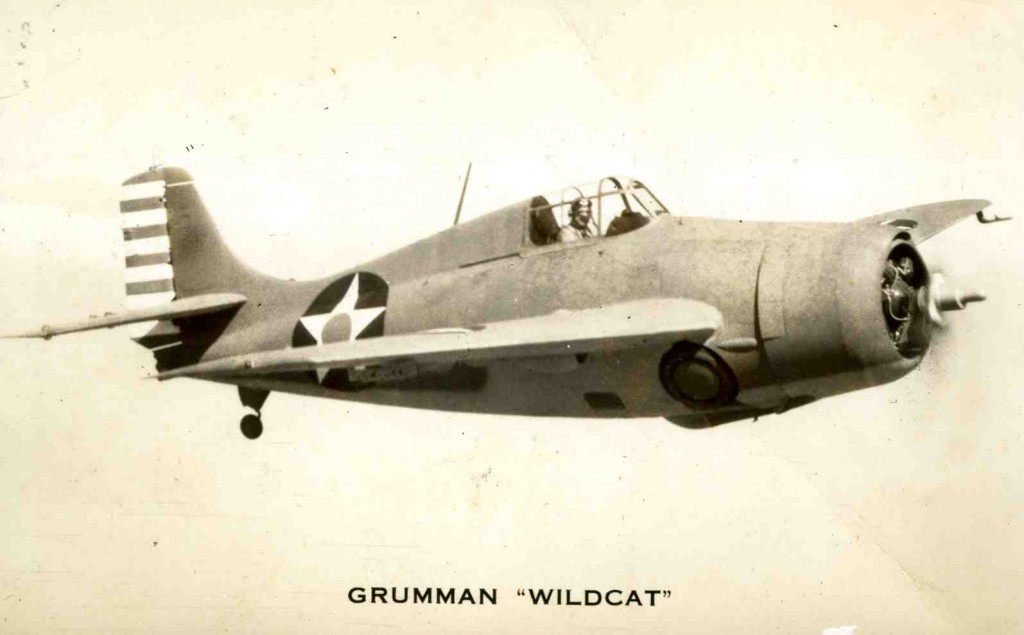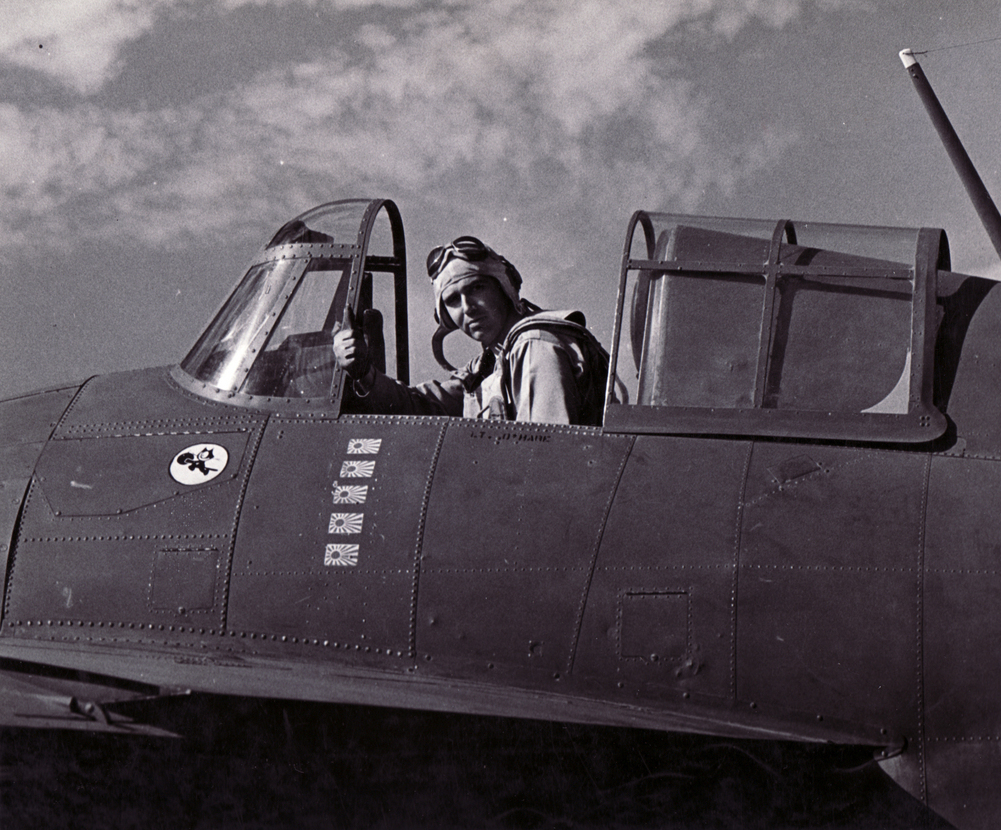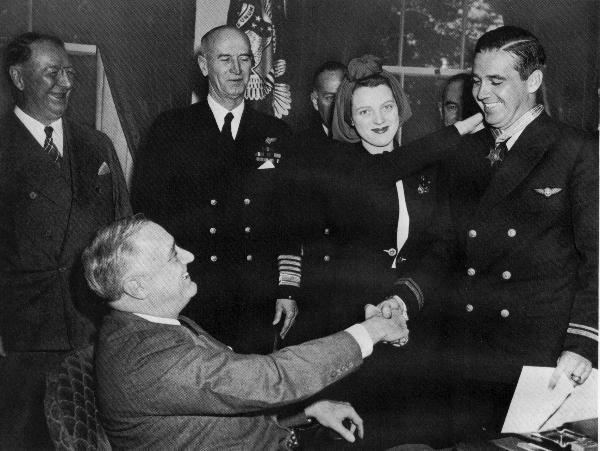Lt. Butch O’Hare: Navy’s First Flying Ace
Lt. Edward Henry “Butch” O’Hare – The First U.S. Navy’s Flying Ace in WWII
On 20 February 1942, Lt. Edward Henry “Butch” O’Hare became the first US Navy’s flying ace in World War II and was awarded the Medal of Honor for his actions in the South Pacific.
In January, the aircraft carrier USS Lexington (CV-2) sailed from Pearl Harbor as the flagship of Vice Adm. Wilson Brown’s commanding Task Force 11 for the South Pacific. Lexington’s mission was to penetrate the enemy-held waters north of New Ireland and destabilize the Japanese position on Rabaul, an important Japanese base at the very tip of New Britain.
In mid-February, Lexington and Task Force 11 entered the waters of the Coral Sea and headed for a strike at Japanese shipping in the harbor at Rabaul scheduled for February 21. Aboard the USS Lexington was Lt. O’Hare with Fighting Squadron Three (VF-3) and their Grumman F4F-3 “Wildcats.”

The back of this postcard reads: “The Grumman ‘Wildcat’ is the standard single-seat fighting plane of the U.S. Navy. It operates from carrier or land base with equal facility. The ‘Wildcat’ has earned an enviable reputation in war action. Lt. Commander Edward O’Hare, flying a “Wildcat,” established a record for modern warfare by shooting down six Japanese bombers in fifteen minutes.” Postcard Gift of Robert Zeller, The National WWII Museum Inc., 2008.502.006
On the morning of 20 February, while still some 453 nautical miles northeast of Rabaul, Task Force 11 was spotted by a Japanese Kawanishi H6K “Mavis” flying boat. The enemy spotter plane was detected by Lexington’s radar some 35 miles from the carrier. A six-plane combat air patrol was launched. Two fighter planes under the command of Lt. Comdr. John Smith “Jimmy” Thach, the Commanding Officer of VF-3, shot down a “Mavis” about 43 miles out, but not before it had radioed Lexington’s position.
Admiral Brown’s plan depended on the element of surprise. With that gone, the attack on Rabaul was canceled. However, Brown decided to proceed towards Rabaul to engage the Japanese aircraft into action. Two other “Wildcats” of the combat air patrol shot down another “Mavis” 35 miles ahead.
The Lexington spotted nine Japanese Mitsubishi G4M1 “Betty” bombers on its radar that afternoon. Lt. Comdr. Thach led a formation of six “Wildcats” into the air to intercept what turned out to be Betty’s carrying 550-pound bombs heading toward the Lexington. During the attack, each of the “Wildcats” destroyed an enemy bomber and two others were damaged. The carrier’s anti-aircraft guns finished the rest.
A half-hour later, the Lexington’s radar picked up a second formation of eight Bettys only 12 miles out. Six more Wildcats of VF-3 were launched from the carrier’s deck among them Lt. “Butch” O’Hare’s plane. The formation split into three sections to search for the enemy. Lt. O’Hare and his wingman Lt. (jg) Marion W. “Duff” Dufilho raced eastward and were the first to locate the Bettys.
The two arrived 1,500 feet above eight attacking “Bettys” nine miles. Having the altitude advantage, they both rolled into the attack. Unfortunately, Lt. (j.g.) Dufilho discovered that his guns were jammed and was forced to turn away.
Lt. O’Hare didn’t hesitate, and attacked the “V” shaped enemy formation of eight Bettys alone. The other four Wildcats of VF-3 were too far away to assist him. Lt. O’Hare made three fast and furious attacks on the enemy bombers. First, he performed a high-side diving attack in which he was able to penetrate the right engine of one of the Bettys. Then he was able to maneuver around and attack another enemy bomber. As he made his third and fourth diving passes, the Bettys flew into the defensive fire of Task Force 11’s combined anti-aircraft guns. Five Japanese Bettys managed to drop their ten 550 lb bombs, but they all missed the wildly maneuvering carrier.

Lt. Edward H. “Butch” O’Hare in his Grumman F4F-3 Wildcat giving a thumbs up at Naval Air Station Kaneohe, Oahu, Hawaii. 10 April 1942. Note “Felix the Cat” insignia of Fighting Squadron Three (VF-3) and five Japanese flags representing the five enemy bombers he was credited with shooting down. Courtesy of The National Archives.
By now Lt. O’Hare was out of ammunition. Luckily for him, Lt. Cmdr. Thach and other Wildcat pilots joined the fight. Lt. O’Hare believed that he had shot down five of the Bettys, and severely damaged a sixth one. Lt. Cmdr. Thach later reported that at one point he saw three of the enemy bombers falling in flames at the same time. He also figured that Lt. O’Hare had used only sixty rounds of ammunition for each Japanese plane he destroyed.
Admiral Brown and Capt. Frederick C. Sherman, the Lexington’s commander, were both of the opinion that Lt. O’Hare’s actions saved the carrier from severe damage or possible loss. In the after-action report, Captain Sherman recommended that Lt. O’Hare be decorated.
Lt. Edward Henry “Butch” O’Hare was credited with five confirmed victories, which made him the first U.S. Navy flying ace of World War II. He was promoted to the rank of Lieutenant Commander and became the first naval aviator to be awarded the Medal of Honor in World War II.

Medal of Honor presentation: President Franklin D. Roosevelt congratulates Lt. Edward H. “Butch” O’Hare upon receipt of the Medal of Honor, the highest military decoration awarded by the United States government.
On 21 April 1942, Lt. O’Hare and his wife Rita were ushered into President Roosevelt’s office at the White House. The President promoted O’Hare to the rank of Lieutenant Commander and awarded him the Medal of Honor in the presence of his wife Rita, Frank Knox – the Secretary of the Navy, Admiral Ernest King, and others. While President Roosevelt was looking on, O’Hare’s wife Rita placed the Medal around her husband’s neck.
The official Medal of Honor citation for Lt. O’Hare reads:
“The President of the United States of America, in the name of Congress, takes pleasure in presenting the Medal of Honor to Lieutenant Edward Henry “Butch” O’Hare (NSN: 0-78672), United States Navy, for conspicuous gallantry and intrepidity in aerial combat, at grave risk of his life above and beyond the call of duty, as section leader and pilot of Fighting Squadron Three (VF-3), attached to the U.S.S. LEXINGTON, on 20 February 1942. Having lost the assistance of his teammates, Lieutenant O’Hare interposed his plane between his ship and an advancing enemy formation of nine attacking twin-engine heavy bombers. Without hesitation, alone and unaided, he repeatedly attacked this enemy formation, at close range in the face of intense combined machinegun and cannon fire. Despite this concentrated opposition, Lieutenant O’Hare, by his gallant and courageous action, his extremely skillful marksmanship in making the most of every shot of his limited amount of ammunition, shot down five enemy bombers and severely damaged a sixth before they reached the bomb release point. As a result of his gallant action–one of the most daring, if not the most daring, single action in the history of combat aviation–he undoubtedly saved his carrier from serious damage.”
While leading the first nighttime fighter raid off of the USS Enterprise (CV-6) on 26 November 1943, O’Hare was presumably killed in action, although his Grumman F6F-3 Hellcat was never found. The USS O’Hare and O’Hare International Airport in Chicago are namesakes of Lt. Butch O’Hare.
Posted by Robert Janous, Assistant Curator at The National WWII Museum
- Posted :
- Post Category :
- Tags : Tags: Medal of Honor, Memorial Day, Navy
- Follow responses to this entry through the RSS 2.0 feed. You can skip to the end and leave a response. Pinging is currently not allowed.
One Response to “Lt. Butch O’Hare: Navy’s First Flying Ace”
Frankie says:
This was a great article and as always a learning read. Look forward to many more!
Leave a Reply



